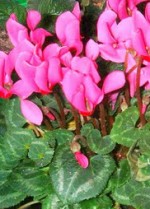 The holiday season brings several special plants to the market and one of the prettiest is the florists cyclamen, C. persicum with its unusual flowers and attractive foliage. The individual flowers hang down from their stalks with all the petals extending upward. The gray green leaves are roundish and have whitish markings on them. Both standard sized forms and mini forms will bloom from fall until spring indoors if kept cool so you get a very big bang for your buck with this one!
The holiday season brings several special plants to the market and one of the prettiest is the florists cyclamen, C. persicum with its unusual flowers and attractive foliage. The individual flowers hang down from their stalks with all the petals extending upward. The gray green leaves are roundish and have whitish markings on them. Both standard sized forms and mini forms will bloom from fall until spring indoors if kept cool so you get a very big bang for your buck with this one!
Type: Tuberous tender herbaceous perennial.
Bloom: Bright pink, white, red, purple or lavender flowers in late fall to winter.
Size: Two forms are available; 6-12”, and mini forms 4-6”.
Light: Bright light without direct sunlight.
Soil: Soil mix of 2 parts peat moss, 1 part loam, 1 part sand.
Fertilizer: Beginning about a month after you receive the plant, apply houseplant fertilizer and half concentration every 3-4 weeks.
Temperatures: Plants will thrive at temperatures between 50 and 60 F. They will die at temperature 35 F and below and go dormant in temperatures 70 F and above. In warm homes, at least put the plant in a cool place (44-59 F) at night.
Water: Water when the soil is dry to the touch but before the plant wilts and give a good soaking. To avoid rotting the tuber, do not water in the center of the plant.
Care: Remove faded flowers and yellow leaves by snapping the stem out of the plant. If it does not come at first try again the next day.
Plants may held over for rebloom but don’t expect the bloom to be exactly like the first one; flowers may be smaller and not as colorful, stems weaker etc. Its fun to get plants to rebloom so here is what you should do. When the plant stops blooming and the leaves turn yellow stop watering and put the pot in a cool place until all the leaves have dried (a matter of months). Repot the tuber in a commercial, peat soil mix if you feel it is necessary, allowing the top half of the tuber to sit above the soil line. Water when the new leaves begin to appear or in late October, which ever is first. Water again when the soil becomes dry. Move to bright light (but cool temperatures) when the new leaves emerge and continue to water when soil dries. Blooms should follow.
Pests and Diseases: Leaf fall is usually caused by bringing the plant into a warm temperature and watering will not cure it. Many problems are caused by over watering, so water only when the soil is dry to the touch. Tuber rot may be avoided by watering at the sides of the pot or immersing the pot in water. Up to but not over the rim. Good air circulation will control the onset of other problems. If plants are grown outside during the summer, watch for aphids, mites, whiteflies, and mealy bugs.
Propagation: Seeds (difficult to germinate and take 15-18 months to reach maturity).
Comments: When choosing a plant look for a few open flowers on upright stems and many buds (may be hidden under the leaves).
